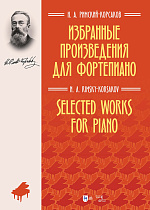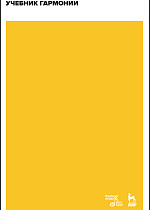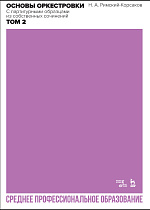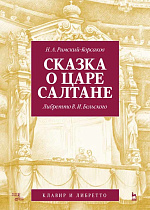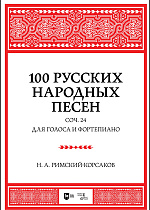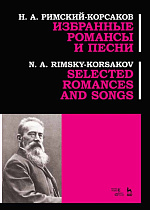Римский-Корсаков Н.А. - все книги автора. Издательство Лань
Сохранить список:
Excel
Excel
Закрыть
Выгрузка списка книг доступна только авторизованным пользователям. Авторизоваться
Фортепианное наследие Николая Андреевича Римского-Корсакова (1844–1908) относительно невелико, однако в последние годы эта сфера творчества привлекает все большее внимание как исследователей, так и исполнителей. В педагогической практике особенно востребованы сочинения дидактической направленности, прежде всего полифонические опусы («6 фуг для фортепиано соч. 17»). Отдельную группу составляют салонные пьесы (соч. 11, 15 и 38). К произведениям концертного репертуара относятся «Шесть вариаций на тему B-A-C-H для фортепиано» соч. 10.
Издание адресовано ученикам старших классов ДМШ, студентам музыкальных училищ и консерваторий, концертирующим пианистам, любителям фортепианной музыки.
The piano heritage of Nikolai Andreevich Rimsky-Korsakov (1844–1908) is relatively small, but in recent years this sphere of his work has attracted increasing attention from both researchers and performers. Didactic works are especially in demand in pedagogical practice, primarily polyphonic opuses (6 Fugues for Piano, op. 17). A separate group is made up of salon pieces (Op. 11, 15, and 38). The works of the concert repertoire include Six Variations on the Theme B-A-C-H for Piano, op. 10.
The edition is addressed to senior pupils of children’s music schools, students of music colleges and conservatories, performing pianists, lovers of piano music.
Издание адресовано ученикам старших классов ДМШ, студентам музыкальных училищ и консерваторий, концертирующим пианистам, любителям фортепианной музыки.
The piano heritage of Nikolai Andreevich Rimsky-Korsakov (1844–1908) is relatively small, but in recent years this sphere of his work has attracted increasing attention from both researchers and performers. Didactic works are especially in demand in pedagogical practice, primarily polyphonic opuses (6 Fugues for Piano, op. 17). A separate group is made up of salon pieces (Op. 11, 15, and 38). The works of the concert repertoire include Six Variations on the Theme B-A-C-H for Piano, op. 10.
The edition is addressed to senior pupils of children’s music schools, students of music colleges and conservatories, performing pianists, lovers of piano music.
Николай Андреевич Римский-Корсаков (1844–1908) — русский композитор, педагог, дирижер, общественный деятель, музыкальный критик; участник «Могучей кучки». Среди его сочинений — 15 опер, 3 симфонии, симфонические произведения, инструментальные концерты, кантаты, камерно-инструментальная, вокальная и духовная музыка. В своем учебнике Н. А. Римский-Корсаков излагает приемы гармонизации мелодии и модуляции, постепенно переходя от простейших средств к более сложным. Учебник снабжен значительным числом гармонических образцов и задач.
Учебник предназначен для студентов и педагогов средних специальных учебных заведений.
Nickolay Andreevich Rimsky-Korsakov (1844–1908) was a Russian composer, a teacher, a director, a public character, a music critic, and a member of “The Mighty Five”. Among his compositions there are 15 operas, 3 symphonies, symphonic music, instrumental concerts, and cantatas; chamber-instrumental, vocal and sacred music. In the book N.A. Rimsky-Korsakov presented the techniques of harmonizing a melody and modulation, gradually coming from the simplest means to more complicated. The textbook is supplied with a considerable amount of harmonic patterns and exercises.
The book is intended for the students and teachers of colleges.
Учебник предназначен для студентов и педагогов средних специальных учебных заведений.
Nickolay Andreevich Rimsky-Korsakov (1844–1908) was a Russian composer, a teacher, a director, a public character, a music critic, and a member of “The Mighty Five”. Among his compositions there are 15 operas, 3 symphonies, symphonic music, instrumental concerts, and cantatas; chamber-instrumental, vocal and sacred music. In the book N.A. Rimsky-Korsakov presented the techniques of harmonizing a melody and modulation, gradually coming from the simplest means to more complicated. The textbook is supplied with a considerable amount of harmonic patterns and exercises.
The book is intended for the students and teachers of colleges.
Данная книга Н.А. Римского-Корсакова впервые вышла в 1913 году и фактически сразу же была переведена на многие языки мира. И по сей день книга "Основы оркестровки" не теряет своей актуальности, ведь она содержит богатый опыт великого композитора. Опыт этот будет очень полезен в подготовке молодых музыкантов. Второй том содержит в себе образцы партитур для изучения студентами. Книга адресована студентам и педагогам музыкальных училищ. This book by N. A. Rimsky-Korsakov first came out in 1913 and, in fact, was immediately translated into many languages. And to this day the book "Principles of Orchestration" is in demand, because it reflects the great composer’s valuable experience. This experience will be very useful in training the young musicians. The second volume contains the scores examples for students to study. The book is addressed to students and teachers of music colleges.
«Сказка о царе Салтане» — последняя из относительно «безмятежных» сказочных опер Римского-Корсакова. В опере использованы традиции народного театра, скоморошьей игры, приемы сказа. Основная ее мысль — искусство и красота побеждают трудности жизни, преображают мир — воплощена в высокопоэтической форме. Либретто предназначено для солистов-вокалистов оперных театров, студентов и педагогов вокальных отделений, а также всем любителям оперного искусства.
«Царская невеста» — выдающаяся опера Н. А. Римского-Корсакова, написанная на либретто композитора И. Ф. Тюменева. В основе сюжета — одноименная драма Льва Мея, отсылающая нас к реальному историческому эпизоду — женитьбе царя Ивана Грозного на Марфе Васильевне Собакиной, скоропостижно скончавшейся через две недели после замужества. И сюжет драмы, и либретто оперы, хоть и погружены в историческую обстановку, не претендуют на достоверность событий. В центре же вни-мания Римского-Корсакова яркие образы героев, глубина и трагизм истории невинной девушки, жгучая любовь, невыносимая ревность и необратимое соперничество. Компо-зитор тонко чувствовал русскую душу, и «Царская невеста», глубоко национальный и самобытный шедевр, этому подтверждение.
Клавир предназначен для солистов-вокалистов оперных театров, студентов и педагогов вокальных отделений, а также всем любителям оперного искусства и музыки Н. А. Римского-Корсакова.
“The tsar’s bride” is an outstanding opera by N. A. Rimsky-Korsakov, written with the libretto of the composer I. F. Tyumenev. The plot is based on the drama by Lev Mei of the same name, which refers to the real episode — Ivan the Terrible’s marriage to Marfa Vasilyevna Sobakina, who died unexpectedly upon two weeks after the event. Neither the drama’s plot, nor the opera’s libretto claim to be historically accurate. The vivid images of the characters, the depth and tragedy of the innocent girl’s story, burning love, unbearable jelaousy and irreversible rivalry are in the centre of Rimsky-Korsakov’s attention. The composer had a gust of the Russian soul, and “The tsar’s bride”, a profoundly national and authentic masterpiece, is a proof of that.
The clavier is for the soloists-vocalists of opera theatres, students and teachers of vocal departments, and also for those who are interested in the opera art and music of N. A. Rimsky-Korsakov.
Клавир предназначен для солистов-вокалистов оперных театров, студентов и педагогов вокальных отделений, а также всем любителям оперного искусства и музыки Н. А. Римского-Корсакова.
“The tsar’s bride” is an outstanding opera by N. A. Rimsky-Korsakov, written with the libretto of the composer I. F. Tyumenev. The plot is based on the drama by Lev Mei of the same name, which refers to the real episode — Ivan the Terrible’s marriage to Marfa Vasilyevna Sobakina, who died unexpectedly upon two weeks after the event. Neither the drama’s plot, nor the opera’s libretto claim to be historically accurate. The vivid images of the characters, the depth and tragedy of the innocent girl’s story, burning love, unbearable jelaousy and irreversible rivalry are in the centre of Rimsky-Korsakov’s attention. The composer had a gust of the Russian soul, and “The tsar’s bride”, a profoundly national and authentic masterpiece, is a proof of that.
The clavier is for the soloists-vocalists of opera theatres, students and teachers of vocal departments, and also for those who are interested in the opera art and music of N. A. Rimsky-Korsakov.
Сборник «100 русских народных песен» был составлен Николаем Андреевичем Рим-ским-Корсаковым (1844–1908) в 1877 г. Сборник объединил песни разных жанров: были-ны и повествовательные песни, лирические, плясовые, игровые, свадебные. Как отмечает сам композитор в предисловии к сборнику, песни были записаны им от родственников, от соратников по «Могучей кучке», а также позаимствованы из других сборников.
Издание адресовано студентам и преподавателям музыкальных учебных заведений и широкому кругу любителей русской народной песни.
The collection of 100 Russian Folksongs was compiled by Nikolay Andreevich Rimsky-Korsakov (1844–1908) in 1877. The collection included songs of different genres: epics and narrative songs, lyrical, dance, playing, and wedding songs. As the composer himself stated in the preface to the collection, the songs have been written down by him from relatives, from “The Mighty Five” colleagues, and also borrowed from other collections.
The edition is addressed to students and teachers of music educational institutions and a wide range of lovers of Russian folk songs.
Издание адресовано студентам и преподавателям музыкальных учебных заведений и широкому кругу любителей русской народной песни.
The collection of 100 Russian Folksongs was compiled by Nikolay Andreevich Rimsky-Korsakov (1844–1908) in 1877. The collection included songs of different genres: epics and narrative songs, lyrical, dance, playing, and wedding songs. As the composer himself stated in the preface to the collection, the songs have been written down by him from relatives, from “The Mighty Five” colleagues, and also borrowed from other collections.
The edition is addressed to students and teachers of music educational institutions and a wide range of lovers of Russian folk songs.
Николай Андреевич Римский-Корсаков (1844–1908) — русский композитор, педагог, дирижер, общественный деятель, музыкальный критик; участник «Могучей кучки». Среди его сочинений — 15 опер, 3 симфонии, симфонические произведения, инструментальные концерты, кантаты, камерно-инструментальная, вокальная и духовная музыка. В своем учебнике Н. А. Римский-Корсаков излагает приемы гармонизации мелодии и модуляции, постепенно переходя от простейших средств к более сложным. Учебник снабжен значительным числом гармонических образцов и задач.
Учебник предназначен для студентов, изучающих курс гармонии, а также преподвателей музыкальных вузов.
Nickolay Andreevich Rimsky-Korsakov (1844–1908) was a Russian composer, a teacher, a director, a public character, a music critic, and a member of “The Mighty Five”. Among his compositions there are 15 operas, 3 symphonies, symphonic music, instrumental concerts, and cantatas; chamber-instrumental, vocal and sacred music. In the book N.A. Rimsky-Korsakov presented the techniques of harmonizing a melody and modulation, gradually coming from the simplest means to more complicated. The textbook is supplied with a considerable amount of harmonic patterns and exercises.
The book is intended for the students, studying the course of harmony, and also for the teachers of music colleges and academies.
Учебник предназначен для студентов, изучающих курс гармонии, а также преподвателей музыкальных вузов.
Nickolay Andreevich Rimsky-Korsakov (1844–1908) was a Russian composer, a teacher, a director, a public character, a music critic, and a member of “The Mighty Five”. Among his compositions there are 15 operas, 3 symphonies, symphonic music, instrumental concerts, and cantatas; chamber-instrumental, vocal and sacred music. In the book N.A. Rimsky-Korsakov presented the techniques of harmonizing a melody and modulation, gradually coming from the simplest means to more complicated. The textbook is supplied with a considerable amount of harmonic patterns and exercises.
The book is intended for the students, studying the course of harmony, and also for the teachers of music colleges and academies.
Данная книга Н.А. Римского-Корсакова впервые вышла в 1913 году и фактически сразу же была переведена на многие языки мира. И по сей день книга "Основы оркестровки" не теряет своей актуальности, ведь она содержит богатый опыт великого композитора. Опыт этот будет очень полезен в подготовке молодых музыкантов.
Книга адресована студентам и педагогам музыкальных училищ и консерваторий.
This book by N. A. Rimsky-Korsakov first came out in 1913 and, in fact, was immediately translated into many languages. And to this day the book "Principles of Orchestration" is in demand, because it reflects the great composer’s valuable experience. This experience will be very useful in training the young musicians.
The book is addressed to students and teachers of music colleges and conservatories.
Книга адресована студентам и педагогам музыкальных училищ и консерваторий.
This book by N. A. Rimsky-Korsakov first came out in 1913 and, in fact, was immediately translated into many languages. And to this day the book "Principles of Orchestration" is in demand, because it reflects the great composer’s valuable experience. This experience will be very useful in training the young musicians.
The book is addressed to students and teachers of music colleges and conservatories.
Жанр романса занял в творчестве Н. А. Римского-Корсакова (1844-1908) далеко не центральное место. Однако композитор создал целый ряд камерно-вокальных сочинений, которые сыграли видную роль в романсовой лирике XIX века. Особое предпочтение Римский-Корсаков отдавал текстам Пушкина, А. Толстого, Майкова, Фета, Гейне.
Издание адресовано профессиональным певцам и любителям музыки.
Издание адресовано профессиональным певцам и любителям музыки.
Данная книга Н.А. Римского-Корсакова впервые вышла в 1913 году и фактически сразу же была переведена на многие языки мира. И по сей день книга "Основы оркестровки" не теряет своей актуальности, ведь она содержит богатый опыт великого композитора. Опыт этот будет очень полезен в подготовке молодых музыкантов.
Книга адресована студентам и педагогам музыкальных училищ.
This book by N. A. Rimsky-Korsakov first came out in 1913 and, in fact, was immediately translated into many languages. And to this day the book "Principles of Orchestration" is in demand, because it reflects the great composer’s valuable experience. This experience will be very useful in training the young musicians.
The book is addressed to students and teachers of music colleges.
Книга адресована студентам и педагогам музыкальных училищ.
This book by N. A. Rimsky-Korsakov first came out in 1913 and, in fact, was immediately translated into many languages. And to this day the book "Principles of Orchestration" is in demand, because it reflects the great composer’s valuable experience. This experience will be very useful in training the young musicians.
The book is addressed to students and teachers of music colleges.


